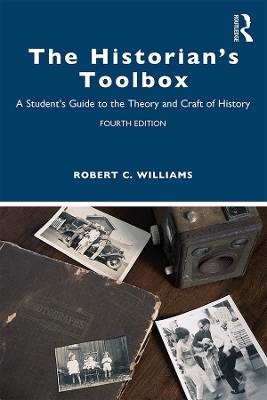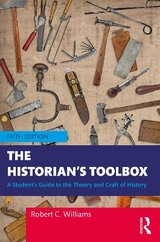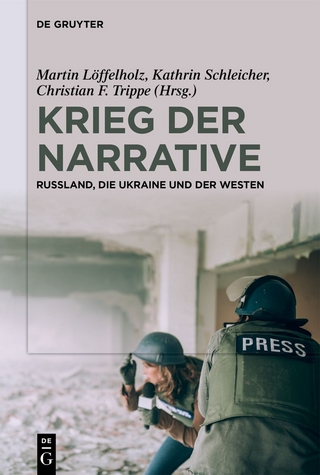
The Historian's Toolbox
Routledge (Verlag)
978-1-138-63217-2 (ISBN)
The Historian’s Toolbox introduces students to the theory, craft, and methods of history and equips them with a series of tools to research and understand the past. Written in an engaging and entertaining style, and filled with fascinating examples, this best-selling "how to" book opens up an exciting world behind historical research and writing.
This fourth edition expands the repertory of tools and techniques available to students entering the workshop of history. These include materials on the Kennedy assassination, the litigation of Van Gogh’s Night Café, local town histories, contemporary history, Twitter, and the contemplation of the end of history as well as the Sixth Extinction in a new epilogue. The book demonstrates the relevance and expanding possibilities of the study of history in our cacophonous information age of tweetstorms and fake news; it emphasises the increasing value of critical thinking, facts and evidence in the face of political lies and conspiracy theories. Material added to the fourth edition will resonate with a new generation of computer-literate readers in the face of climate change.
The Historian’s Toolbox continues to be a seminal text for supporting students throughout their study of history and an accessible teaching tool for instructors.
Robert C. Williams is Vail Professor of History Emeritus at Davidson College. He has taught Russian, European and American history at Williams and Bates Colleges and at Washington University in St. Louis. He is the author of numerous books and articles, including Russian Art and American Money (1980), nominated by Harvard University Press for the Pulitzer Prize.
Contents
Illustrations and Tables
History as Fun
Part I. The Craft of History
1. The Past
2. Story
3. History
4. Metahistory
5. Antihistory
6. The Present
7. The Future
Part II. The Tools of History
8. Doing History: An Overview
8.1 Choosing a Good Paper Topic
8.2 Reading History
8.3 Taking Notes
8.4 How to Write a Good History Paper
9. Sources and Evidence
9.1 Primary and Secondary Sources
Primary Source: The Wannsee Protocol (1942)
Secondary Source: Denying History: Who Says the Holocaust Never Happened and Why Do They Say It? (2000)
Summary
9.2 Documents
A Revolutionary War Ancestor’s Pension Application (1832)
9.3 Maps
Sebastian Munster’s Map of the Americas, c. 1540
9.4 Artifacts
Digging Ancient Moscow
9.5 Images
Sharpshooter’s Home or Photographer’s Studio?
9.6 Cliometrics: Using Statistics to Prove a Point
The Black Population of Colonial America
9.7 Genetic Evidence
Welsh and Basques, Relatively Speaking
Thomas Jefferson and Sally Hemings—What’s My Line?
10. Credit and Acknowledgment
10.1 Notes
10.2 Bibliography
Styling Your Bibliography
Types of Bibliographies
A Selective, Annotated Bibliography
10.3 Acknowledging Sources and Avoiding Plagiarism
10.4 Professional Plagiarism: How Not to Do History
11. Narrative and Explanation
11.1 The Language of the Historian
Paul Revere and the New England Village
11.2 Chronology
The Life of Margaret Fuller
11.3 Narrative
Pickett’s Charge at Gettysburg
11.4 Argument
"‘Little Women’ Who Helped Make This Great War"
11.5 Causation
11.6 The Reasons Why
Explaining the Mann Gulch Fire of August 5, 1949
12. Interpretation
12.1 Reviewing History
Bellesiles’s Arming America
12.2 Historical Revision
The Denmark Vesey Slave Conspiracy (1822)
12.3 Historiography
World War II
12.4 Women’s History: The Leo Frank Case
13. Speculation
13.1 Historical Speculation
Will the Real Martin Guerre Please Get an Identity?
13.2 History as Fiction
The Soldier Who Never Was
13.3 Conspiracies
Who Really Really Killed Lincoln?
13.4 Forgeries and Facsimiles
Is a Document Genuine?
Is a Collection of Documents Authentic?
How Can Forgeries Influence History?
Is a Newly Discovered Collection by a Well-Known Author Authentic?
If It Is a Forgery, Who Is the Forger?
13.5 Fiction as History
13.6 Film as History: Fact or Fiction?
Films Can Help the Historian Understand the Past
Films Can Hinder Our Understanding of the Historical Past
Part III. The Relevance of History
14. Everyday History
14.1 Studying Ordinary People
The Burgermeister’s Daughter
14.2 Everyone’s a Historian
14.3 Local History. A Tale of Two Towns
15. Oral History
15.1 The Perils of Memory
15.2 Interviewees and Interviewers
The WPA Slave Narratives
15.3 Techniques of Oral History
16. Material Culture
16.1 Spirits in the Material World Richard Bushman and The Refinement of America
16.2 Studying Material Culture
16.3 Provenance and Ownership. Tracing Stolen Art
17. Public History
17.1 History Beyond the Ivory Tower
17.2 History and the Public
The Enola Gay Controversy
18. Event Analysis
18.1 History in Real Time
The Iraq War: Munich, Mukden, or Mexico?
19. New Tools: GIS and CSI
19.1 Spatial History: Geographic Information Systems
19.2 Killer App: Crime Scene Investigation Forensics
20. History on the Internet
20.1 Using the Internet: Promises and Pitfalls
20.2 Wikipedia and "Wikiality"
20.3 Blogging the Past (and Present)
21. TMI: Too Much Information
21.1 History as Information
21.2 Hacking History: The Deluge of WikiLeaks
21.3 Private Parts: The Intrusion of History
21.4 Twitter
22. Epilogue: The End of History?
Glossary
Selected Bibliography
Index
| Erscheinungsdatum | 20.12.2019 |
|---|---|
| Zusatzinfo | 2 Tables, black and white; 20 Halftones, black and white; 20 Illustrations, black and white |
| Verlagsort | London |
| Sprache | englisch |
| Maße | 152 x 229 mm |
| Gewicht | 272 g |
| Themenwelt | Kunst / Musik / Theater |
| Schulbuch / Wörterbuch ► Lexikon / Chroniken | |
| Geisteswissenschaften ► Geschichte ► Geschichtstheorie / Historik | |
| Geisteswissenschaften ► Geschichte ► Hilfswissenschaften | |
| ISBN-10 | 1-138-63217-1 / 1138632171 |
| ISBN-13 | 978-1-138-63217-2 / 9781138632172 |
| Zustand | Neuware |
| Haben Sie eine Frage zum Produkt? |
aus dem Bereich



